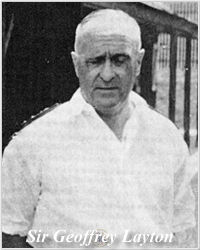 Geoffrey Layton was born on 20th April 1884, the son of George Layton, a Liverpool solicitor.
Geoffrey Layton was born on 20th April 1884, the son of George Layton, a Liverpool solicitor.
Layton entered H.M.S. Britannia as a naval cadet in May 1899 and, on leaving that establishment, his early days as a Midshipman were spent aboard cruisers firstly in the English Channel and, later, off the South Coast of America.
His Lieutenant's course was undertaken in 1905 and this led him towards the submarine branch of the navy that was to be the mainstay of his service for the next 20 years. The years 1905 to 1910 were spent entirely in submarines, and included his first command. Following two years general service he returned to submarines in 1912 and commanded a succession of these vessels during the First World War.
The dramatic highlight of Layton's war came on 18 August 1915 when his command, the submarine E13, was ordered to the Baltic to assist the Russians. Due to a failure of the vessel's compass he ran around on Saltholm off the Danish coast. E13 was destroyed early the following morning by the German torpedo boat G132. 14 men were killed and 15 others, to include Layton, ended up in internment at Copenhagen. Not downcast by his experience, Layton began to plan his return to Britain and the War. Three months later disguised as a local sailor he made good his plans and, in an adventure that included swimming a canal, he managed to return to Britain. At the end of the war he was awarded the D.S.O. To read more about the end of E13, please visit Danish Naval History 1801-2001.
His career continued to have close connections with submarines and after promotion to the rank of Captain he held the post of Chief of Staff to the Rear Admiral (Submarines).
The second half of the 1920s saw him take up post at the Admiralty as deputy Director of Operations and in 1930 he attended the course at the Imperial Defence College that was the mark of so many Senior British Service commanders of the Second World War.
From 1931 to 1933, in many ways an overture to his wartime service, he was posted as Chief of Staff on the China station.
Then started a period of service aboard the "Big Ships". Firstly the Renown and, following another period at the Admiralty, the period in command of the Battle Cruiser squadron which saw him fly his flag in H.M.S. Hood.
Following his big ship period Layton was transferred to the Mediterranean where he was 2nd in Command of the Mediterranean fleet firstly under Pound and later under Cunningham.
1940 saw the move to the Far East that was to be his greatest test. Due to the demands elsewhere – most notably the Atlantic and the Mediterranean – the British naval presence in the East had been cut to the bone, but by late 1941 it was clear that Japanese aggression was imminent. The fateful decision was taken and Hood's former comrade-in-arms Prince of Wales headed east flying the flag of Admiral Tom Phillips, together with the Battlecruiser Repulse.
Within a week of their arrival at Singapore both ships and Admiral Phillips were lost, and the Japanese had struck at Pearl Harbour and mainland Malaya. Layton was thrown into the breach and took over from Phillips as Commander in Chief. At this stage the action was largely rearguard, but the tide turned in the spring of 1942 when, after the loss of Java, the Japanese started air attacks on Ceylon. Layton had been given power over all military and civil forces on the island and the defences had been well prepared. The attack was repulsed – the Japanese suffering heavy losses of aircraft – and was never renewed.
Following the war Layton returned to the UK as Commander in Chief, Portsmouth a post he held until his retirement in 1947.
Geoffrey Layton died at Portsmouth on 4th September 1964 at the age of 80.
Sources and References
Roskill SW: The War at Sea (4 Volumes, H.M.S.O.)
Middlebrook & Mahoney: Battleship: The loss of Prince of Wales and Repulse (Allen Lane, 1977)
Connell J: Wavell: Supreme Commander (Collins, 1969)
Barnett C: Engage the Enemy more Closely (Hodder & Stoughton, 1991)
Hough R: The Hunting of Force Z (Collins, 1963)
Navy Lists (courtesy of J.N. Houterman)